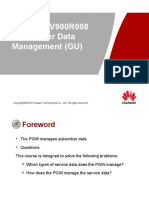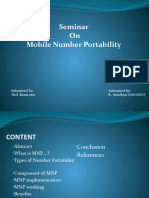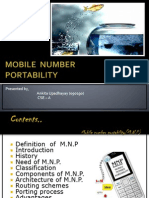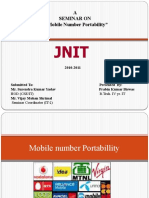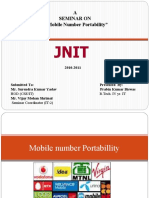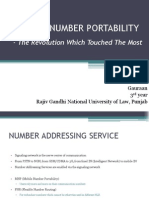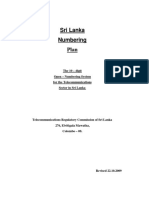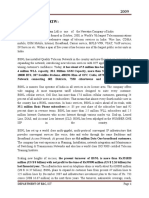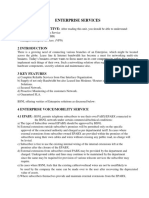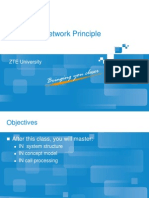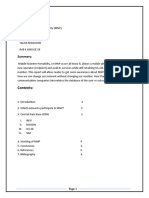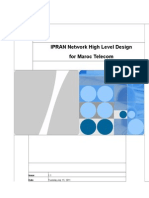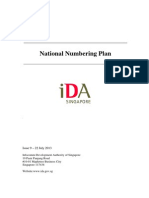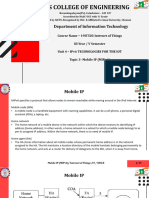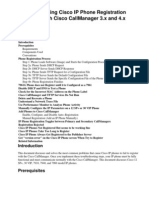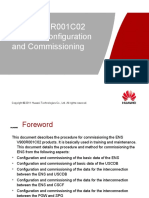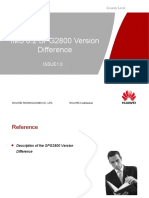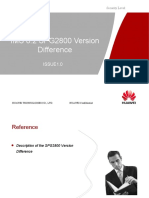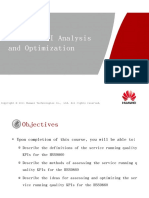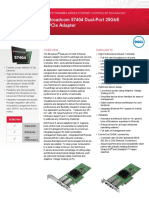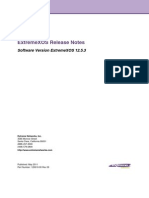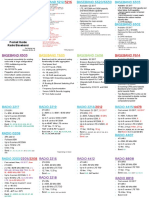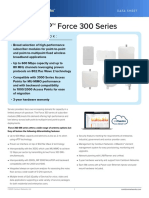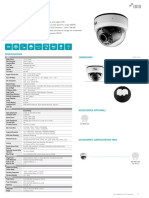¡ IMS 8.2¡¿INAP NP Service and 800 Service of The UGC3200
¡ IMS 8.2¡¿INAP NP Service and 800 Service of The UGC3200
Uploaded by
sirjimyCopyright:
Available Formats
¡ IMS 8.2¡¿INAP NP Service and 800 Service of The UGC3200
¡ IMS 8.2¡¿INAP NP Service and 800 Service of The UGC3200
Uploaded by
sirjimyOriginal Title
Copyright
Available Formats
Share this document
Did you find this document useful?
Is this content inappropriate?
Copyright:
Available Formats
¡ IMS 8.2¡¿INAP NP Service and 800 Service of The UGC3200
¡ IMS 8.2¡¿INAP NP Service and 800 Service of The UGC3200
Uploaded by
sirjimyCopyright:
Available Formats
INAP NP Service and 800
Service of the UGC3200
www.huawei.com
Copyright © 2010 Huawei Technologies Co., Ltd. All rights reserved.
Foreword
This document describes how to implement the NP service
and the 800 service on the UGC3200 based on the application
scenarios, implementation principle, and service configuration
of the INAP NP service.
Copyright © 2010 Huawei Technologies Co., Ltd. All rights reserved.
Training Objectives
Upon completion of this course, you will be able to:
Understand the basic concepts of the INAP NP service of the UGC3200.
Understand the implementation principle of the INAP NP service of the UGC3200.
Understand the key configuration of the INAP NP service of the UGC3200.
Understand the basic concepts of the 800 service of the UGC3200.
Understand the implementation principle of the 800 service of the UGC3200.
Copyright © 2010 Huawei Technologies Co., Ltd. All rights reserved.
Contents
1. Basic Concepts of the INAP NP Service
2. Application Scenarios of the INAP NP Service
3. Implementation Principle of the INAP NP Service
4. Service Configuration of the INAP NP Service
5. Service Configuration Examples of the INAP NP Service
6. Basic Concepts of the 800 Service
7. Implementation Principle of the 800 Service
Copyright © 2010 Huawei Technologies Co., Ltd. All rights reserved.
Basic Concepts of the INAP NP Service
Definition:
NP: The number portability (NP) service allows a subscriber to retain the existing directory number after subscribing
to another network within a country or region. All services of the subscriber are provided by the new subscription
network and not affected by the original subscription network.
Related concepts:
NP: Number Portability
The NP service allows a subscriber to retain the existing directory number after subscribing to another network
within a country or region. All services of the subscriber are provided by the new subscription network and not
affected by the original subscription network.
CIC: Carrier Identification Code
It is a parameter used for carrier preselection. The UGC3200 selects a carrier for call routing based on this
parameter.
NRN: Network Routing Number
The NRN returned from the NP database (NPDB) to the UGC3200.
PDIC: Point of Inter-Connection
The PDIC is used for call connection when two network entities (NEs) are not directly connected.
Copyright © 2010 Huawei Technologies Co., Ltd. All rights reserved.
Application Scenarios of the INAP NP Service
The service is applicable to the public switched telephone network (PSTN) and IP Multimedia
Subsystem (IMS) networks where the UGC3200 functions as a media gateway control function
(MGCF). With the NP service, subscribers can retain the existing directory number after
subscribing to a new network. During service implementation, the UGC3200 queries the NPDB by
using the Intelligent Network Application Part (INAP) protocol. The application scenarios are as
follows:
1.In a call originated from the IMS, the MGCF queries the NPDB and processes the call based on
the query results.
2.In a call originated from the PSTN, if the called number contains the CIC, the MGCF strips the
CIC from the called number and routes the call to the actual home network of the called party.
Copyright © 2010 Huawei Technologies Co., Ltd. All rights reserved.
Implementation Principle of the INAP NP Service
After receiving a call routed from the IMS to the PSTN, the MGCF queries the MNP Service Prefix table based on
the CIC (if contained) and the called number to determine whether to trigger the NP service. If the NP service
needs to be triggered, the MGCF queries the NPDB by using the INAP protocol.
If the NRN contained in the CONNECT message returned by the NPDB is different from the called number
contained in the IDP message used to query the NPDB, the MGCF determines that the called number has been
ported. The MGCF then directly routes the call out based on the CIC (if contained) and the NRN. The format of the
called number for routing is "CIC (if contained) + NRN + D (special separator) + called number."
When the NRN contained in the CONNECT message returned by the NPDB is the same as the called number
contained in the IDP message used to query the NDPB, the NPDB returns a CONTINUE message to the MGCF,
or the MGCF fails to query or does not query the NPDB, the MGCF determines that the called number has not
been ported. The MGCF then queries the local database for a PDIC number based on the CIC (if contained), the
called number (in national number format), and the calling number (in national number format).
1.If the PDIC number is obtained, the MGCF routes the call based on the PDIC number. The format of the called
number for routing is "PDIC + CIC (if contained) + called number."
2.If the PDIC number is not obtained, the MGCF routes the call based on the CIC (if contained) and the called
number. The format of the called number for routing is "CIC (if contained) + called number."
Copyright © 2010 Huawei Technologies Co., Ltd. All rights reserved.
Implementation Principle of the INAP NP Service
The service procedure is as follows:
1. After receiving an incoming call without the CIC from the IMS, the MGCF queries the NPDB
based on the called number and the called number has been ported.
The service procedure is as follows:
P1: After receiving an INIVITE request from the IMS, the MGCF queries the MNP Service Prefix table to
determine whether to query the NPDB. If such a query is required, the MGCF sends an IDP
message to the NPDB. The calling number and called number in the IDP message are normalized.
P2: The MGCF receives a CONNECT message from the NPDB and determines whether the called
number has been ported. If the NRN contained in the CONNECT message is different from the
called number contained in the IDP message, the MGCF determines that the called number has
been ported and sends an IAM message to the terminating network based on the NRN. The format
of the called number contained in the IAM message is "NRN + D (a special separator) + called
number (in national number format)."
Copyright © 2010 Huawei Technologies Co., Ltd. All rights reserved.
Implementation Principle of the INAP NP Service
2. After receiving an incoming call without the CIC from the IMS, the MGCF determines
that the called number has not been ported.
The service procedure is as follows:
P1: After receiving an INIVITE request from the IMS, the MGCF queries the MNP Service Prefix table based on the
called number to determine whether to query the NPDB. If such a query is required, the MGCF sends an IDP
message to the NPDB. The calling number and called number in the IDP message are normalized.
The MGCF continues the processing based on the results obtained from the NPDB.
L1: After receiving the RELEASECALL message from the NPDB, the MGCF releases the call.
L2: After receiving the CONTINUE message from the NPDB, the MGCF determines that the called number
has not been ported and continues to connect the call.
L3: After receiving the CONNECT message from the NPDB, the MGCF detects that the NRN contained in the
CONNECT message is the same as the called number contained in the IDP message and determines that the
called number has not been ported. Then the MGCF continues to route the call.
Copyright © 2010 Huawei Technologies Co., Ltd. All rights reserved.
Implementation Principle of the INAP NP Service
3. After receiving an incoming call from the PSTN, the MGCF directly routes the call to the IMS.
The service procedure is as follows:
P1: After receiving an IAM message from the PSTN, the MGCF queries the CIC Information table based on the
called number and determines whether the called number contains the CIC. If the called number contains
the CIC, the MGCF strips the CIC from the called number and considers the called number without the CIC
as the new called number. Then, the MGCF sends an INVITE request to the IMS based on the CIC and
the called number. The INVITE request contains the called number in international number format and the
CIC (if contained).
Copyright © 2010 Huawei Technologies Co., Ltd. All rights reserved.
Implementation Principle of the INAP NP Service
4. After receiving an incoming call with the CIC from the IMS, the MGCF directly routes the call to the
IMS.
The service procedure is as follows:
P1: After receiving an INVITE request containing the CIC from the IMS, the MGCF queries the MNP Service Prefix Table based on the CIC and called
number to determine whether to query the NPDB. If such a query is required, the MGCF sends an IDP message to the NPDB.
P2: The MGCF receives a CONNECT message from the NPDB and determines whether the called number has been ported.
If the NRN contained in the CONNECT message is different from the called number contained in the IDP message, the MGCF determines that
the called number has been ported and routes the call based on the CIC and NRN. The called number in the IMA message is in "CIC + NRN +
D (a special parameter) + called number" format.
If the NRN contained in the CONNECT message is the same as the called number contained in the IDP message, the MGCF determines that
the called number has not been ported. The MGCF then queries the local database for the PDIC number based on the CIC and the called
number (in national number format).
Copyright © 2010 Huawei Technologies Co., Ltd. All rights reserved.
Service Configuration of the INAP NP Service
List of commands
1. The ADD MNP command is used to configure the NP service. To configure the INAP NP service, MNP
processing type is set to FIXED IN based NP query and service key is selected. Otherwise, the service
key is invisible.
2. The ADD IDPNPRO command is used to configure whether to change the number contained in the IDP
message.
3. The ADD TDPAC command is used to configure the TDP access code.
4. The ADD TDPCFG command is used to configure the TDO configuration information.
5. The ADD SCPINFO command is used to configure the SCP address information.
6. The ADD SCPCFG command is used to add the SCP configuration information.
7. The ADD SCPPARA command is used to add the SCP parameter information.
8. The ADD SSPINFO command is used to configure the SSP physical address.
9. The ADD SSNSRV command is used to add a service type of the SSN.
Copyright © 2010 Huawei Technologies Co., Ltd. All rights reserved.
Service Configuration of the INAP NP Service
Task examples:
/*Configure the INAP NP service.*/
ADD MNP: CSN="MVNO", CALLFROM=ISUP, CLDPFX=K'B0584, MINDNLEN=5, MAXDNLEN=32, MNPPFT=UNKNOWN, MNPPRT=FIXINBASED,
SRVKEY=1;
/*Configure the called number analysis.*/
ADD CNACLD: P=10, PFX=K'B0584, CSA=LCT, RSNAME="msx_hw_isup", MINL=4, MAXL=32;
/*Configure whether to change the number and whether to change the number contained in the IDP message.*/
ADD DNC: DCN="RMV_B058", DCT=TYPE6, DCL=4;
ADD IDPNPRO: CNTYP=NGN, SRVKEY=1, INTRGTP=ALL, NUMT=CLD, NUMPFX=K'B0584, NUMADDRTYP=ALL, MAXLEN=32,
NCNAME="RMV_B058";
/*Add SSP configuration. The IDP message contains only the caller, caller and service key.*/
ADD SSPCFG: SSPINDEX="SSPCFG", ITAEGET=IDP, IMASK=CEDNUM-1&CINGNUM-1;
/*Add the TDP access code.*/
ADD TDPAC: ACNAME="FSCP", ACODE=K'40141225;
/*Add the TDP configuration.*/
ADD TDPCFG: NETTYPE=NGN, DPNO=DP3, CODE="FSCP", SKEY=0, CSRCWLCDF=NO, CSRCNAME="MVNO";
/*Add the SCP address information.*/
ADD SCPINFO: SCP="FSCP", INVER=INAP_RU, SSNF=YES, RT=DPC, DPC="111999", SSN=ss251, SCFID="333";
/*Add an SCP configuration table.*/
ADD SCPCFG: SKEY=0, NETTYPE=NGN, ISSPCFG="SSPCFG", SNAME=PPS, SCPADDRNAME0="FSCP";
/*Add the SSP physical address.*/
ADD SSPINFO: SCP="FSCP", DPCF=YES, SSNF=YES, RT=DPC, OPC="1199", SSN=ss250;
/*Add the service type of the SCCP SSN.*/
ADD SSNSRV: SSN=SSN251, SVT=INAP;
Copyright © 2010 Huawei Technologies Co., Ltd. All rights reserved.
Basic Concepts of the 800 Service
Definition:
An IMS subscriber dials the 800 number. Then the CSCF routes the
call to the MGCF based on the IM-SSF mode and the MGCF
triggers the 800 service based on the service key configured by the
CSCF by using the INAP protocol. The MGCF makes calls to the
CSCF in the outgoing INVITE message by replacing Request URI
with the query number according to the query results.
Copyright © 2010 Huawei Technologies Co., Ltd. All rights reserved.
Implementation Principle of the 800 Service
The service flow is as follows:
IMS IM-SSF SG7000 CSCF
INVITE
Intial_dp
CONNECT
INVITE
Copyright © 2010 Huawei Technologies Co., Ltd. All rights reserved.
Implementation Principle of the 800 Service
The implementation principle of the 800 service is described as follows:
1. The IM-SSF determines whether to trigger the IN service on whether to trigger the IN based on the parameter information about the Route header
field of the incoming INVITE message.
The format of the Route header is as follows:
Route: <sip:im-ssf@huawei.com:5060;lr;orig;scpaddr=G-xxxxxx;servicekey=xx;ssf=xxxxxxx>;sip:10.8.2.53:10228;lr;ORGDLGID=6d-1.
The first route of the Route header field includes domain name, port number, and caller process (orig) of the IM-SSF, IN type, SCP address (scpaddr),
service key (servicekey) information, and the IMSI.
2. The IM-SSF triggers the IN service to the SG7000, and carries related information about the caller and the callee, IN service key and SCP address.
3. The SG7000 determines the service as an INAP800 service based on the IN service key, and returns a CONNECT message to the IM-SSF. The
message contains the redirecting number.
4. The IM-SSF routes the call to the CSCF by replacing the redirecting number in the CONNECT message with the Request URI number.
Copyright © 2010 Huawei Technologies Co., Ltd. All rights reserved.
Thank you
www.huawei.com
Copyright © 2010 Huawei Technologies Co., Ltd. All rights reserved.
You might also like
- Dial Plan and Call Routing Demystified On Cisco Collaboration Technologies: Cisco Unified Communication ManagerFrom EverandDial Plan and Call Routing Demystified On Cisco Collaboration Technologies: Cisco Unified Communication ManagerNo ratings yet
- PTCL Business ProcessDocument6 pagesPTCL Business ProcessRE Abdul Basit MianNo ratings yet
- Alcatel-Lucent Service Routing Architect (SRA) Self-Study Guide: Preparing for the BGP, VPRN and Multicast ExamsFrom EverandAlcatel-Lucent Service Routing Architect (SRA) Self-Study Guide: Preparing for the BGP, VPRN and Multicast ExamsNo ratings yet
- HSS9860 V900R008C20 Subscriber Data Management (GU)Document103 pagesHSS9860 V900R008C20 Subscriber Data Management (GU)sirjimyNo ratings yet
- Catalyst 8500 Configuration GuidelinesDocument32 pagesCatalyst 8500 Configuration GuidelinesApple Johnnyseed100% (1)
- Hierarchical QoS and Policies Aggregation PDFDocument71 pagesHierarchical QoS and Policies Aggregation PDFVladan ColakovicNo ratings yet
- MNP PP PresentationDocument37 pagesMNP PP PresentationNealNo ratings yet
- CDR2Document33 pagesCDR2markmwalimu100% (1)
- Mobile Number PortabilityDocument29 pagesMobile Number PortabilitychaituNo ratings yet
- Nepal IvrDocument4 pagesNepal IvrSushant SanyaNo ratings yet
- Mobile Number Portability in IndiaDocument17 pagesMobile Number Portability in IndiaNathdwara BoyssNo ratings yet
- Alcatel Response To IDA NPDocument9 pagesAlcatel Response To IDA NPskid235No ratings yet
- CSE Mobile Number Portability PPT.507Document18 pagesCSE Mobile Number Portability PPT.507botlasandhya891No ratings yet
- MNP PP PresentationDocument37 pagesMNP PP PresentationJaySharanNo ratings yet
- "Study On Working Culture of Vodafone India Service Pvt. LTDDocument18 pages"Study On Working Culture of Vodafone India Service Pvt. LTDSachin KakkadNo ratings yet
- INgfgDocument32 pagesINgfgJason RogersNo ratings yet
- Mobile Number Portability - Theory, Introduction and Types of Solutions AvailableDocument5 pagesMobile Number Portability - Theory, Introduction and Types of Solutions AvailableKalaarangan100% (1)
- Chapter 3 Part 2 Cont'dDocument41 pagesChapter 3 Part 2 Cont'd4zfq8g84rkNo ratings yet
- CSE Mobile Number PortabilityDocument22 pagesCSE Mobile Number PortabilityJeshwanth KachhwaNo ratings yet
- Advanced Intelligent NetworksDocument3 pagesAdvanced Intelligent NetworksYidnekachwe MekuriaNo ratings yet
- MNP OverviewDocument35 pagesMNP Overviewrawat1757No ratings yet
- Presented By, Ankita Upadhayay (090190) Cse - ADocument37 pagesPresented By, Ankita Upadhayay (090190) Cse - AAnkita UpadhayayNo ratings yet
- Mobile Number PortabilityDocument24 pagesMobile Number PortabilityNiranjan RajawatNo ratings yet
- Commercial Free Call Service: Mode of OperationDocument3 pagesCommercial Free Call Service: Mode of OperationEugen BleulerNo ratings yet
- Introduction To The RAN14.0 Feature-Enhanced IP PMDocument43 pagesIntroduction To The RAN14.0 Feature-Enhanced IP PMMohamed Abdel MonemNo ratings yet
- A Seminar On " Mobile Number Portability"Document24 pagesA Seminar On " Mobile Number Portability"Savita AabhitaNo ratings yet
- User Manual For IN - V2.1Document39 pagesUser Manual For IN - V2.1nilesh asnaniNo ratings yet
- Ivrs 9Document24 pagesIvrs 9Amit Kumar SinhaNo ratings yet
- Emergency Call Handling in Voip NetworksDocument4 pagesEmergency Call Handling in Voip NetworksMark AldissNo ratings yet
- IntDocument5 pagesIntGoutham BaratamNo ratings yet
- Proposal IP TransitDocument8 pagesProposal IP TransitAndryNo ratings yet
- Intelligent Network: User Manual, May, 2013Document36 pagesIntelligent Network: User Manual, May, 2013nilesh asnaniNo ratings yet
- Mobile Number Portability FinalDocument16 pagesMobile Number Portability FinalNaresh Kumar SharmaNo ratings yet
- Mobile-Number-Portability FinalDocument24 pagesMobile-Number-Portability Finalpradeep_sharma_1867% (3)
- Cisco Voice Lab3 - Jan - 13 - QuestionsDocument34 pagesCisco Voice Lab3 - Jan - 13 - Questionsnasirhusain12345100% (2)
- Sri Lanka Numbering Plan: The 10 - Digit Open - Numbering System For The Telecommunications Sector in Sri LankaDocument8 pagesSri Lanka Numbering Plan: The 10 - Digit Open - Numbering System For The Telecommunications Sector in Sri Lankamalinga lokugamageNo ratings yet
- Mobile Virtual Network Operator (MVNO)Document7 pagesMobile Virtual Network Operator (MVNO)KalaaranganNo ratings yet
- CBN Proposal IP TransitDocument8 pagesCBN Proposal IP TransitAndryNo ratings yet
- ss7 InapDocument108 pagesss7 InapVladimir TsagovNo ratings yet
- Interconnect Billing ManualDocument65 pagesInterconnect Billing ManualMuhammad NasirNo ratings yet
- CBN Proposal IP Transit - PT Wahana Internet Nusantara (BNET)Document8 pagesCBN Proposal IP Transit - PT Wahana Internet Nusantara (BNET)AndryNo ratings yet
- Vijay FINALDocument16 pagesVijay FINALAshutosh SinghNo ratings yet
- EB Faculty - Enterprise Mobile Services Broadband - VPNDocument10 pagesEB Faculty - Enterprise Mobile Services Broadband - VPNagmebaldNo ratings yet
- Intelligent Network Principle: ZTE UniversityDocument32 pagesIntelligent Network Principle: ZTE UniversityyosephwansaraNo ratings yet
- Prepking 920-139 Exam QuestionsDocument11 pagesPrepking 920-139 Exam Questionsmebrojs98No ratings yet
- Report On MNPDocument6 pagesReport On MNPtalha2905No ratings yet
- Chapter 5.mobile - IN PDFDocument9 pagesChapter 5.mobile - IN PDFronyiutNo ratings yet
- Mobile Number PortabilityDocument24 pagesMobile Number PortabilityLavanya ReddyNo ratings yet
- HLD Report Ipran Iam v2Document33 pagesHLD Report Ipran Iam v2Younes BlxNo ratings yet
- Day 2 - 1 - FTTH - DETAILED - PRESENTATION - 07.02.2022Document76 pagesDay 2 - 1 - FTTH - DETAILED - PRESENTATION - 07.02.2022Meher VenkateshNo ratings yet
- NNP WDDocument107 pagesNNP WDKONNANELBARBARONo ratings yet
- Mobile Number Portability in IndiaDocument12 pagesMobile Number Portability in IndiaverarvindNo ratings yet
- iot u4 t4Document13 pagesiot u4 t4vijaysudhakar760No ratings yet
- Unit IiiDocument40 pagesUnit IiiVENU VNo ratings yet
- Sip Trunk Between U19xx and Cisco Call Maanger - Huawei Enterprise Support CommunityDocument19 pagesSip Trunk Between U19xx and Cisco Call Maanger - Huawei Enterprise Support CommunityTony KhouryNo ratings yet
- Troubleshooting Cisco Ip Phone Registration Problems With Cisco Callmanager 3.X and 4.XDocument23 pagesTroubleshooting Cisco Ip Phone Registration Problems With Cisco Callmanager 3.X and 4.XGopi KothandaramanNo ratings yet
- An Introduction to SDN Intent Based NetworkingFrom EverandAn Introduction to SDN Intent Based NetworkingRating: 5 out of 5 stars5/5 (1)
- Wireless Telecommunications Carrier Revenues World Summary: Market Values & Financials by CountryFrom EverandWireless Telecommunications Carrier Revenues World Summary: Market Values & Financials by CountryNo ratings yet
- Creating Location Services for the Wireless Web: Professional Developer's GuideFrom EverandCreating Location Services for the Wireless Web: Professional Developer's GuideRating: 3 out of 5 stars3/5 (1)
- Mastering Nmap - A Guide to Network Scanning & Security: Security BooksFrom EverandMastering Nmap - A Guide to Network Scanning & Security: Security BooksNo ratings yet
- Building Enterprise Ready Telephony Systems with sipXecs 4.0From EverandBuilding Enterprise Ready Telephony Systems with sipXecs 4.0No ratings yet
- EC-Council Certified Network Defender (CND) Exam Practice TestsFrom EverandEC-Council Certified Network Defender (CND) Exam Practice TestsNo ratings yet
- Internal Message Trace Guide - Training Slide: Security LevelDocument46 pagesInternal Message Trace Guide - Training Slide: Security LevelsirjimyNo ratings yet
- (IMS 8.2) CSCF H248 Feature TrainingDocument43 pages(IMS 8.2) CSCF H248 Feature Trainingsirjimy100% (1)
- (IMS 8.2) ENS V900R001C02 Product Configuration and CommissioningDocument57 pages(IMS 8.2) ENS V900R001C02 Product Configuration and CommissioningsirjimyNo ratings yet
- ¡ IMS 8.2¡¿SPG2800 Version Differences (Between R3C02 and R3C01)Document23 pages¡ IMS 8.2¡¿SPG2800 Version Differences (Between R3C02 and R3C01)sirjimyNo ratings yet
- ¡ IMS 8.2¡¿UGC3200 Supporting New R3 BoardsDocument16 pages¡ IMS 8.2¡¿UGC3200 Supporting New R3 BoardssirjimyNo ratings yet
- ¡ IMS 8.2¡¿SPG2800 Version Differences (Between R3C02 and R3C01)Document23 pages¡ IMS 8.2¡¿SPG2800 Version Differences (Between R3C02 and R3C01)sirjimyNo ratings yet
- HSS9860 V900R008C20 Data Configuration and O&M (LTE)Document51 pagesHSS9860 V900R008C20 Data Configuration and O&M (LTE)sirjimyNo ratings yet
- HSS9860 KPI Analysis and OptimizationDocument62 pagesHSS9860 KPI Analysis and OptimizationsirjimyNo ratings yet
- Broadcom 57404 Dual Port 25GbEDocument2 pagesBroadcom 57404 Dual Port 25GbETestgame GameonlyNo ratings yet
- GH Cp343-1ex30 76Document67 pagesGH Cp343-1ex30 76KoertBNo ratings yet
- ExtremeXOS 12.5.3 RelNote Rev02Document100 pagesExtremeXOS 12.5.3 RelNote Rev02Christopher PlainteNo ratings yet
- EC2352 CN Notes - NPRDocument150 pagesEC2352 CN Notes - NPRKarthick VijayanNo ratings yet
- Sunlite Gige: Key Features Test FeaturesDocument2 pagesSunlite Gige: Key Features Test FeaturesNelsonNo ratings yet
- Distance Vector AlgorithmDocument6 pagesDistance Vector AlgorithmMehtaz ShirinNo ratings yet
- Ericsson Radio System: Baseband T605Document3 pagesEricsson Radio System: Baseband T605Nabil ZAIDINo ratings yet
- Acl 4.2.2.10 Packet Tracer - Configuring Extended ACLs Scenario 1Document3 pagesAcl 4.2.2.10 Packet Tracer - Configuring Extended ACLs Scenario 1Emerson Emerson AemersonNo ratings yet
- (Proakis J.G.) Digital Signal Processing. PrinciplDocument60 pages(Proakis J.G.) Digital Signal Processing. Principllhslhin100% (1)
- RSLogix Gateway ConfigDocument9 pagesRSLogix Gateway ConfigLuis TecaNo ratings yet
- Task 1: Investigate The CAMDocument3 pagesTask 1: Investigate The CAMIonut StanciuNo ratings yet
- Huawei OceanStor Dorado V6 Series Storage Systems Optimal NAS ConfigurationDocument1 pageHuawei OceanStor Dorado V6 Series Storage Systems Optimal NAS Configurationlia.castleNo ratings yet
- Ac 500Document138 pagesAc 500Thai TranNo ratings yet
- 1:Rr Channel Request: Cell Mobile Network Fixed NetworkDocument4 pages1:Rr Channel Request: Cell Mobile Network Fixed Networkshin_chan0% (1)
- Chendu College of Engineering and TechnologyDocument47 pagesChendu College of Engineering and Technologysureshh52No ratings yet
- ePMP™ Force 300 Series: Quick LookDocument9 pagesePMP™ Force 300 Series: Quick LookAlex IskandarNo ratings yet
- SMB University 120307 Networking Fundamentals PDFDocument38 pagesSMB University 120307 Networking Fundamentals PDFJacques Giard100% (1)
- Open System Assignment1Document3 pagesOpen System Assignment1cicyNo ratings yet
- Lecture 10 IP Traffic Management-QoS ConceptsDocument45 pagesLecture 10 IP Traffic Management-QoS ConceptsprakashNo ratings yet
- CE2307 Network Lab Set3Document3 pagesCE2307 Network Lab Set3balainsaiNo ratings yet
- Tugas Praktikum Routing Dan Switching 3 (6.3.3.6)Document19 pagesTugas Praktikum Routing Dan Switching 3 (6.3.3.6)OBEMARLEYNo ratings yet
- RadiusDocument24 pagesRadiusAmarpreet SinghNo ratings yet
- Huawei Optix Osn 7500: Universal Transport Platform For Metro Aggregation & CoreDocument6 pagesHuawei Optix Osn 7500: Universal Transport Platform For Metro Aggregation & CoreHuasuda TelecomNo ratings yet
- Cloud Hoppers Weather Station Using Arduino Uno Board and Ethernet ShieldDocument7 pagesCloud Hoppers Weather Station Using Arduino Uno Board and Ethernet ShieldPaul GomezNo ratings yet
- PW2X - HF2211 - HF2221 - HF9610 Operation Guide 20200623Document51 pagesPW2X - HF2211 - HF2221 - HF9610 Operation Guide 20200623NGUYEN HUU DAONo ratings yet
- Universal Serial Bus (USB)Document30 pagesUniversal Serial Bus (USB)BhashiNo ratings yet
- Data and Computer CommunicationsDocument79 pagesData and Computer CommunicationsHarsh VivekNo ratings yet
- DC D4533RX PDFDocument1 pageDC D4533RX PDFMarco Julcapoma MoralesNo ratings yet



